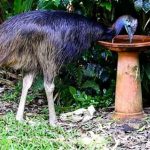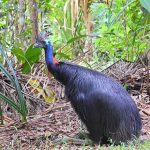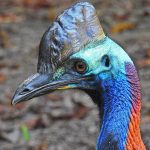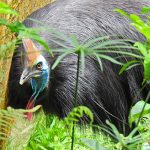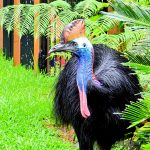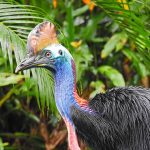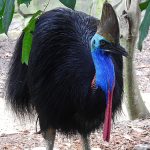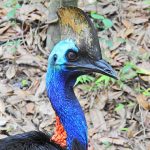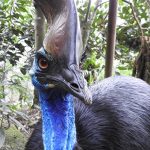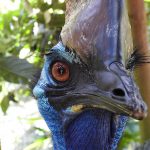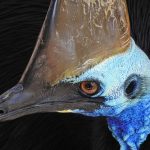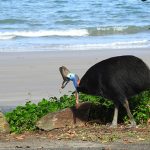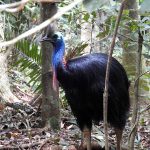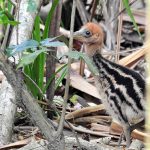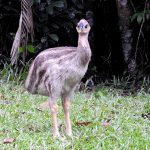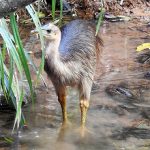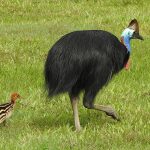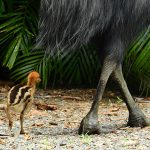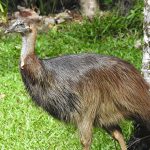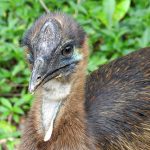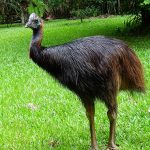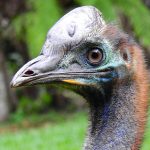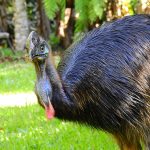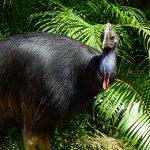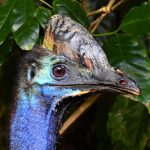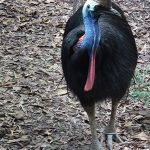CASSOWARY
Guardian of the Rainforest-A Living Relic of Australia’s Ancient Forests
Deep within the emerald heart of Australia’s tropical rainforests, a striking figure stalks the shadows—the Cassowary. This ancient, flightless bird moves with quiet authority. With its iridescent blue neck, ebony feathers, and that unmistakable helmet-like casque, the cassowary is a living link to a world that predates humanity itself.
Vivid Portrait: Cassowary Up Close
Imagine the gentle glow of filtered sunlight, dappling through layers of lush rainforest canopy. Amidst this symphony of green, you glimpse a flash of sapphire and scarlet. You hear the soft crunch of leaf litter beneath feet the size of a dinner plate. Stand close enough, and you’ll notice:
- Colours that captivate: Their necks shimmer in shades ranging from brilliant turquoise to deep violet. Their cheeks and wattles—those fleshy, hanging folds—burn with the intensity of a tropical sunset.
- A natural hard hat: The casque, tall and bony, rises above the bird’s head like a crown. Scientists believe it helps cassowaries push through dense undergrowth and might serve as a resonator for their distinctive calls.
- Powerful defence: Each foot is armed with a long, razor-sharp middle toe—capable of slicing through thick roots and, crucially, dissuading potential threats.
A Life of Solitude and Speed
Unlike their distant relatives—the Ostrich or Emu—cassowaries are fiercely solitary. Most of their days are spent foraging in silence, listening for the gentle plop of ripe fruit falling through the forest air.
Behaviour at a Glance
| Feature | Description |
|---|---|
| Height | Up to 2 metres |
| Weight | 40–73 kilograms |
| Speed | Up to 50 km/h in short bursts |
| Defence | Dagger-like claws for powerful kicks |
| Diet | Fruits, berries, seeds, insects, small creatures |
| Lifespan | Up to 40 years in the wild |
Ecological Role: The ‘Rainforest Gardener’
When cassowaries eat, they swallow fruit whole—seeds and all. Their digestive journey doesn’t destroy these seeds; instead, it prepares them for life. Through their droppings, cassowaries disperse hundreds of plant species across kilometres, ensuring the regeneration and variety of the rainforest. Without cassowaries:
- Forest structure would shift
- Plant diversity could decline
- Many rare species might be lost forever
Sensory World: Sound, Smell, and Movement
The rainforest is a world of bold sensations. Listen closely, and you might hear the cassowary’s haunting “wom-wom-wom” call reverberate through the thick air. This deep, rumbling tone is almost felt in your chest—travelling further than higher-pitched bird calls could, slicing through the green hush even when the bird itself is hidden by foliage.
The air is humid, the earthy scent of wet soil mingling with the tang of fallen fruit—a reminder that cassowaries, though elusive, are never far away.
Threats and Conservation
Main Threats
- Habitat loss: Deforestation for agriculture and development encroaches on their home.
- Road accidents: Encounters with vehicles endanger birds moving between habitat fragments.
- Hunting and predation: Both humans and introduced species threaten eggs and young.
The cassowary is listed as Vulnerable by the International Union for Conservation of Nature (IUCN). Each year, their rainforest homes shrink a little more—a sobering call for action.
A Bird Woven into Culture
To the Indigenous peoples of northern Australia, cassowaries are more than just birds. They feature in ancient stories, carry spiritual significance, and are depicted in vibrant artworks. They serve as a reminder of the delicate balance between people and their environment.
If You Encounter a Cassowary…
These birds are beautiful but wild. They should always be treated with respect and caution:
- Do not approach
- Do not feed
- Give the animal ample space
- Slowly back away if you feel threatened
Remember—the rainforest’s survival depends on guardians like the cassowary. By learning about and protecting these remarkable birds, we help preserve the tangled, ancient forests for future generations of humans—and for the countless creatures that call them home.
Cassowaries are not just icons of Australia’s rainforests—they are lifelines, shaping and sustaining the world around them. Treat their habitat with care and wonder, and you help ensure that their wild, haunting calls will echo through the forests for centuries to come.


